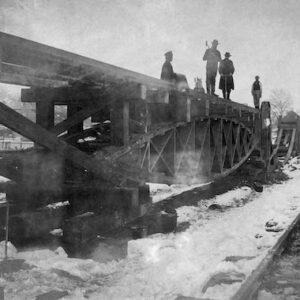| Credit: | by Russell (Andrew J.) |
|---|---|
| Date: | 1863.02-03 |
| Negative Size: | 6.5 in. x 8.5 in. |
| Equipment: | barrel; rail; rope; toolbox |
| Locations & Lines: | Alexandria VA; Orange & Alexandria Railroad (O&A); Virginia |
| Military Units: | US Military Railroads (USMRR); US Army |
| Transports: | USMRR flatcar 190 |
| Sources: | Huntington Library; J. Paul Getty Museum; Lehigh University; Library of Congress |
$5.99
File Details: AABBm, 600 DPI, TIFF, Original Photograph, 17.6 Mb
Image ID: AABB
USMRR flat car no. 190. A young African-american considers the camera.
Haupt, United States Military Railway Department. Construction And Transportation. No. 27. Second Experiment with Board Trusses. – This truss was 60 feet long, the clear span 56 feet, height of truss 6 feet. The top and bottom arches were each composed of six boards, one inch thick and twelve inches wide; the surfaces of the boards were covered with pitch; the boards, as they were successively placed, were nailed with tenpenny nails, four inches apart; at intervals of one foot apart were placed two half inch bolts, compressing the boards tightly, and spikes, six inches long, were driven through the boards at intervals of four inches. Boards were also nailed vertically on the sides
The bridge was loaded until it broke. The breaking weight was 95 tons, 30 tons of which were on the car; the equivalent was about 105 tons, uniformly distributed.
When the truss broke, it appeared that the built-chord had acted as a solid piece; there was no slipping of the boards upon each other. The fractures of the six boards, on each lower chord, were nearly at the same point. Assuming five of the boards to have resisted the tensile strain, the breaking strain was 2,900 lbs. per square inch. The top chords did not break.







